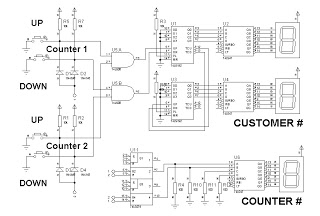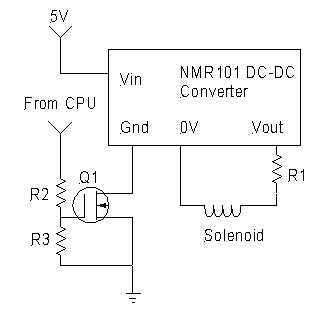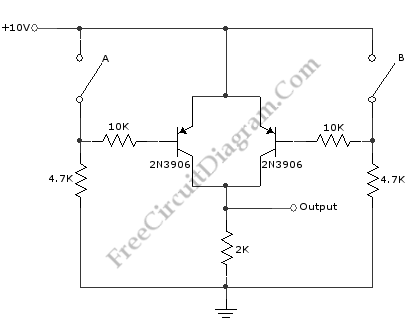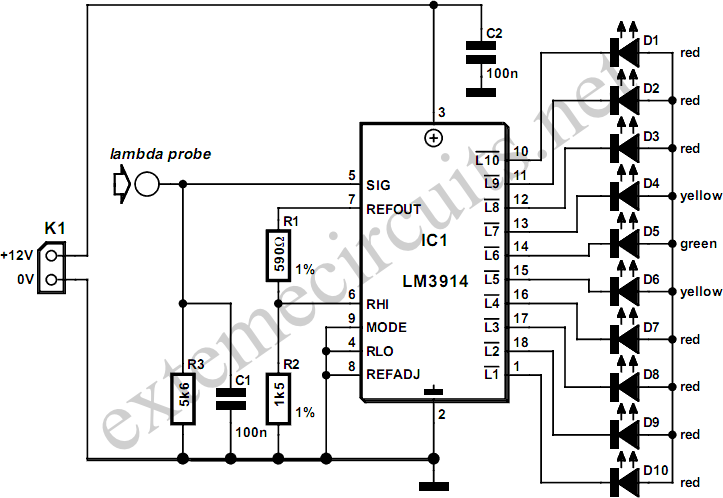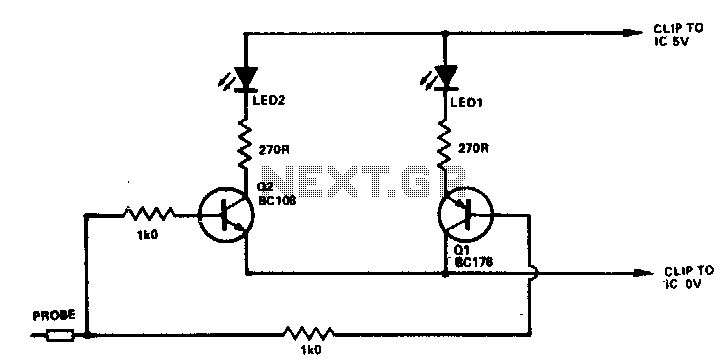
S1Ngle-Ic Logic Probe

This logic probe utilizes a CD4009 CMOS hex inverter. The high-input impedance characteristic of CMOS technology prevents loading of the circuit under test. Since the output of the inverters is not defined at either a high or low level with a floating input, an input-bias network generates low signals at both pairs of input inverters when the input is open or below 2 V. Resistor R3 maintains the input of inverter 3 at a low state, which results in the outputs of inverters 4 and 5 also being low, preventing LED 2 from illuminating. Simultaneously, resistor R1 keeps the inputs of inverters 1 and 2 high, ensuring their output remains low and LED 1 does not light up. When the probe input is connected to a logic low, R3 holds the output of inverter 3 high, while inverters 1 and 2 transition to low, causing their outputs to go high and activating LED 1. In the absence of an input, both LEDs remain off.
The logic probe circuit is designed to diagnose and test digital circuits by indicating the logic levels present at various points in the circuit. The CD4009 hex inverter is a versatile component in this configuration, as it provides the necessary inversion of signals while maintaining a high input impedance, which is crucial for avoiding interference with the circuit under test.
The input-bias network, which consists of resistors R1 and R3, is critical for establishing the default state of the inverters. When the circuit is not connected to any logic level, the biasing ensures that both outputs remain low, preventing false indications. This is particularly important in scenarios where the probe may be inadvertently left floating, as it helps avoid misleading readings.
When the probe is applied to a logic low, the circuit behavior changes. The low input causes inverter 3 to output a high signal, which in turn influences the states of inverters 1 and 2. This cascading effect is a fundamental aspect of the logic probe's operation, enabling it to clearly indicate the presence of a low logic level by illuminating LED 1.
The two LEDs serve as visual indicators of the logic states. LED 1 indicates a logic high output from inverters 1 and 2, while LED 2 indicates the state of inverters 4 and 5. The careful arrangement of resistors and inverters allows for a straightforward and effective means of monitoring digital signals, making this logic probe a valuable tool for electronics testing and troubleshooting.
Overall, this logic probe circuit exemplifies a practical application of CMOS technology in digital electronics, providing an efficient and reliable method for assessing logic levels in various electronic systems. This logic probe uses a CD4009 CMOS hex inverter. The characteristic high-input impedance of CMOS gives the advantage of not loading the circuit being tested. Because the output of the inverters is not specified at either a high or low level with a floating input, an input-bias network produces lows at both input inverter pairs if the input is open or at less than 2 V. Resistor R3 holds the input of inverter 3 low which makes the output of inverters 4 and 5 low and will not permit LED 2 to light.
At the same time, Rl holds the inputs of inverters 1 and 2 high so that their output is low and LED 1 will not light. If the probe input is touched to a logic low, the output of inverter 3 is held high by R3 and inverter 1 and 2 are brought low, which causes their outputs to go high and turns on LED 1.
With no input, both LEDs should be off.
The logic probe circuit is designed to diagnose and test digital circuits by indicating the logic levels present at various points in the circuit. The CD4009 hex inverter is a versatile component in this configuration, as it provides the necessary inversion of signals while maintaining a high input impedance, which is crucial for avoiding interference with the circuit under test.
The input-bias network, which consists of resistors R1 and R3, is critical for establishing the default state of the inverters. When the circuit is not connected to any logic level, the biasing ensures that both outputs remain low, preventing false indications. This is particularly important in scenarios where the probe may be inadvertently left floating, as it helps avoid misleading readings.
When the probe is applied to a logic low, the circuit behavior changes. The low input causes inverter 3 to output a high signal, which in turn influences the states of inverters 1 and 2. This cascading effect is a fundamental aspect of the logic probe's operation, enabling it to clearly indicate the presence of a low logic level by illuminating LED 1.
The two LEDs serve as visual indicators of the logic states. LED 1 indicates a logic high output from inverters 1 and 2, while LED 2 indicates the state of inverters 4 and 5. The careful arrangement of resistors and inverters allows for a straightforward and effective means of monitoring digital signals, making this logic probe a valuable tool for electronics testing and troubleshooting.
Overall, this logic probe circuit exemplifies a practical application of CMOS technology in digital electronics, providing an efficient and reliable method for assessing logic levels in various electronic systems. This logic probe uses a CD4009 CMOS hex inverter. The characteristic high-input impedance of CMOS gives the advantage of not loading the circuit being tested. Because the output of the inverters is not specified at either a high or low level with a floating input, an input-bias network produces lows at both input inverter pairs if the input is open or at less than 2 V. Resistor R3 holds the input of inverter 3 low which makes the output of inverters 4 and 5 low and will not permit LED 2 to light.
At the same time, Rl holds the inputs of inverters 1 and 2 high so that their output is low and LED 1 will not light. If the probe input is touched to a logic low, the output of inverter 3 is held high by R3 and inverter 1 and 2 are brought low, which causes their outputs to go high and turns on LED 1.
With no input, both LEDs should be off.
